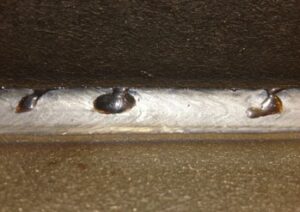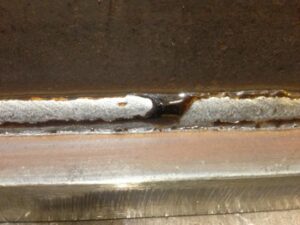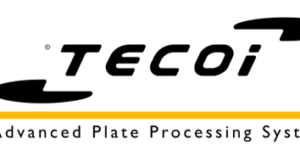Positively Impact your Bottom Line with the Proper Filler Metal
Higher quality filler metals may be more expensive up front, but what they save in weld prep, rework and weld quality can have positive financial impacts across the entire production cycle.
Posted: January 4, 2024

A successful metal fabrication operation doesn’t boil down to just one thing — it’s a combination of factors that build on one another, hopefully to result in a profitable venture. To maximize the financial success of your metalworking operation, you need to look at the entirety of your production and identify places to improve efficiency and cut profit-zapping costs.
No matter your industry, an often-overlooked place to start is in the selection of filler metal. It’s a small percentage of the overall cost of a completed product or part, but it can make a big difference in workpiece — and overall operational — outcomes. Selecting the best filler metal for your specific application can help you minimize pre- and post-weld activities and minimize non-value-added tasks. That translates to more arc-on time, a higher operating factor, enhanced productivity and a bottom line that lands you in the black.
The Impacts of the Right Filler Metal on Upstream Operations
Filler metal selection is important because it can directly impact the quality, strength and integrity of your parts. The right selection helps not only ensure that the weld performs as expected and meets the specific requirements of the application but can also positively impact upstream activities.

Managing mill scale: Scale occurs when heat-treated steel oxidizes, which then creates a patchy, flaky layer on the metal. Scale can have a negative effect on welding processes, such as incomplete fusion, porosity, inclusions and other discontinuities that can result in weld defects and lead to costly rework.
To avoid expensive rework, many shops will utilize wire brushes, grinders or even have their components sandblasted to remove scale, but these are time-consuming and costly processes that take operators away from their core responsibility of welding. Switching from a solid wire to a metal-cored wire is one method to help mitigate the need for these pre-weld cleaning operations. Metal-cored wire is designed to provide high deposition rates and improved weld quality and appearance, while offering a higher appeal for operators compared with solid wire, especially when dealing with light mill scale or oxidation. In many applications, pre-weld cleaning operations can be reduced or eliminated with the introduction of a high-quality, metal-cored wire that’s been designed to solve these frustrations.
Bridging the gap: Gaps can occur where two pieces are brought together to be welded — a result of how the parts were cut and prepared prior to fitting. One way to remedy misfitting pieces is to assess the cutting processes and fine-tune them to be more precise and repeatable. That can be a time- and cost-intensive process. Alternatively, selecting a filler metal that can successfully bridge larger gaps can help mitigate these concerns.
Metal-cored wires will generally help you bridge bigger gaps due to the smoother transfer and lower welding current at a given deposition rate than solid wire. Metal-core wire also provides a wide, smooth penetration profile that can lessen burn-through on thinner materials or on parts with wider gaps to fill.
The Impacts of the Right Filler Metal on Downstream Operations
After laying a weld, it’s important to review your work to ensure the integrity of the weld and help prepare it for its intended purpose. At this juncture, it will be easy to see how effective the filler metal was, as it can contribute to obvious defects such as excess spatter, contaminants and defects. The right filler metal can minimize post-weld cleanup, which can lead to your welders spending more time welding and less time cleaning the welds they just made.
Navigating silicon islands: Silicon is used in filler metals as a deoxidizer to help collect impurities in the molten weld pool. During the welding process, silicon from the filler metal bonds with impurities such as oxygen, causing a chemical reaction that results in silicon islands that float to the top of the finished weld. Silicon islands are a problem because they cost time and money to remove. However, a proper filler metal with silicon control technology, will make these islands large, easily visible and quicker to remove.
The risk of not removing silicon islands can negatively impact a workpiece in two ways. First, if a finished workpiece needs to be painted, the islands can flake off after painting and leave the uncoated metal exposed underneath. Not only will it look aesthetically unpleasing due to the missing paint, but it can also result in rusting the exposed metal and potentially compromising the weld. Second, silicon islands can migrate into the weld toes during multipass welding and lead to inclusions. Inclusions can increase stress in the weld, leading to cracking and, potentially, weld failure.
Minimizing non-value-added work: Using the right filler metal from the get-go not only provides the appropriate mechanical and chemical properties for the job at hand but can also impact a metalworking operation from top to bottom. That’s why it’s important to choose a filler metal based on the application, base material and requirements of the project — not just whatever is conveniently on hand. Failure to select the best filler metal increases the risks of weld defects and discontinuities — which can lead to time-consuming and costly cleanup and/or rework.
When time is money, ensuring you have a productive, profitable operation is essential. To help ensure peak profitability, assessing the entire operation is essential to identify areas for improvement. Evaluating the effectiveness of your current filler metal is a viable option for seeing benefits throughout the production process. Higher quality filler metals may be more expensive up front, but what they save in weld prep, rework and weld quality can have positive financial impacts across the entire production cycle — and that’s where a few extra dollars make major cents.













